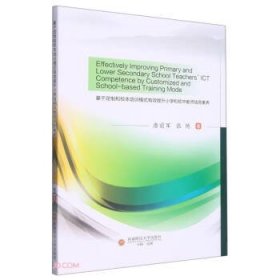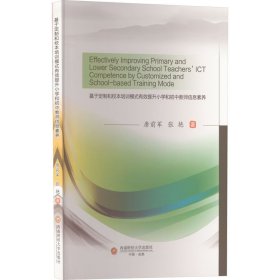
基于定制和校本培训模式有效提升小学和初中教师信息素养
新华官方库房直发,支持开票
¥ 45.24 5.8折 ¥ 78 全新
库存5件
作者唐前军、张艳 著
出版社西南财经大学出版社
出版时间2022-11
版次1
装帧平装
货号文轩9.15
上书时间2024-09-13
- 在售商品 暂无
- 平均发货时间 14小时
- 好评率 暂无
- 店主推荐
- 最新上架
商品详情
- 品相描述:全新
图书标准信息
- 作者 唐前军、张艳 著
- 出版社 西南财经大学出版社
- 出版时间 2022-11
- 版次 1
- ISBN 9787550455764
- 定价 78.00元
- 装帧 平装
- 开本 16开
- 页数 240页
- 字数 290.000千字
- 正文语种 简体中文
- 【内容简介】
- 当今社会, 包括信息技术(ICT)在内的几乎所有的行业都发生了翻天覆地的变化。其中,笔者通过调研发现,中小学教师对信息通信技术教学缺乏信心,他们的教学能力有待进一步提高。本书主要论述了笔者设计的一种自下而上的基于定制和校本培训模式,来有效提升中小学教师的信息素养,笔者采用t检验或方差分析方法检验组别、性别、年龄、学校层次、学校地点、任教科目、培训模式等因素的影响,并经过多次测试发现:训练模式的差异比其他因素对于提升信息技术能力产生的差异更显著。本书对于研究提升中小学教师信息技术教学具有较好的参考价值。
- 【作者简介】
- 唐前军,教授,毕业于帕拉茨基大学(捷克),教育技术学博士研究生,现任教于乐山师范学院教育科学学院,研究方向教育信息化。张艳,讲师,毕业于电子科技大学,计算机专业硕士研究生,现任教于乐山师范学院,研究方向为软件工程、计算机。
- 【目录】
- Contents1 Introduction / 1 1.1 Background of the study / 11.1.1 Background of the era / 21.1.2 Background of the policy / 31.1.3 Background of the related project / 5 1.2 Theoretical basis of this study / 51.2.1 Theory of motivation / 61.2.2 Constructivism learning theory / 81.2.3 Positivism and post?positivism / 12 1.3 Purpose of the study / 15 1.4 Research questions / 17 1.5 Definitions of terms / 191.5.1 Educational informatization / 191.5.2 Information and communication technology (ICT) / 201.5.3 The competency of ICT / 21 1.6 Delimitation & limitations / 212 Literature review / 23 2.1 Overview / 232.1.1 The outline of the educational system and ICT educationin China / 232.1.2 Describe simply the structure of my review / 272.2 The status of teachers?? ICT competence / 282.2.1 The basic informatization situation in schools / 282.2.2 Status of teachers . ICT skills / 282.2.3 Teachers . attitude and perception towards ICT / 30 2.3 Training teachers?? ICT skills / 312.3.1 The related policies / 322.3.2 The related projects / 332.3.3 The related studies / 342.3.4 Findings on teacher training of ICT competency / 35 2.4 The main findings from the literature review / 373 Methodology of the research / 39 3.1 Design the study / 393.1.1 Determine the research topic / 393.1.2 The steps to carrying out the study / 413.1.3 The important characteristics of the study design / 473.1.4 Pertinent hypotheses about the research process / 483.1.5 The reasonable and scientific of the study design / 49 3.2 The feasibility of the study / 503.2.1 The previous study of my pertinent to this study / 503.2.2 The feasibility of accessing to the schools and the participants / 513.2.3 Some ethical issues in the study / 52 3.3 Data collection procedures / 533.3.1 The types of data collection / 533.3.2 Sampling / 553.3.3 Recording data / 56 3.4 Data analysis procedures / 573.4.1 Sorting data / 573.4.2 Quantitative data analysis / 58 3.5 Methods for verification / 603.5.1 Triangulation approach / 603.5.2 Validity and reliability / 613.5.3 The generalizability / 624 Procedure and results / 64 4.1 Pre?research and results / 644.1.1 The validity and reliability of the questionnaires / 644.1.2 The results in the pre?research / 66 4.2 Sampling and the participants / 724.2.1 Sample of schools / 724.2.2 Sample of trainees / 734.2.3 Constructing experimental group and control group / 76 4.3 Pretest and the data / 764.3.1 Introduce the test / 764.3.2 The data of the pretest / 784.3.3 Test the difference between the two groups / 78 4.4 Training / 814.4.1 Training content and schedule time / 814.4.2 Training process / 84 4.5 Posttest and analyze the data / 934.5.1 The posttest / 934.5.2 Compare the posttest with the pretest of all participants / 934.5.3 Compare the posttest with the pretest in the control group / 954.5.4 Compare the posttest with the pretest in the experimentalgroup / 964.5.5 Compare the enhancement of the two groups / 974.5.6 Analysis of gender factor / 984.5.7 Analysis of other dichotomous variables / 1054.5.8 Analysis of the two nominal factors / 109 4.6 Presentation of some results by statistics / 1144.6.1 Some results in the questionnaires / 1144.6.2 Some results in the pretest / 1154.6.3 Some results in the post?test / 1155 Conclusions and recommendations / 120 5.1 Discussion and findings / 120 5.2 Summarize the study / 122Reference / 124Appendix / 137 Part A Questionnaire / 137Questionnaire I: Participants?? ICT skills and hardware in school / 137Questionnaire II: Participants?? self?confidence on ICT competence / 141 Part B Test / 148I Pre?test paper / 148II Data of tests / 157Acknowledgement / 160
相关推荐
-

基于定制和校本培训模式有效提升小学和初中教师信息素养、
全新北京
¥ 45.80
-

基于定制和校本培训模式有效提升小学和初中教师信息素养
全新广州
¥ 42.07
-

基于定制和校本培训模式有效提升小学和初中教师信息素养
全新广州
¥ 40.07
-

基于定制和校本培训模式有效提升小学和初中教师信息素养
全新广州
¥ 40.07
-

基于定制和校本培训模式有效提升小学和初中教师信息素养
全新广州
¥ 42.07
-

基于定制和校本培训模式有效提升小学和初中教师信息素养
全新保定
¥ 35.22
-

基于定制和校本培训模式有效提升小学和初中教师信息素养
全新南京
¥ 49.14
-

基于定制和校本培训模式有效提升小学和初中教师信息素养
全新保定
¥ 33.58
-

基于定制和校本培训模式有效提升小学和初中教师信息素养、
全新北京
¥ 47.80
-

基于定制和校本培训模式有效提升小学和初中教师信息素养
全新保定
¥ 34.40
— 没有更多了 —





















以下为对购买帮助不大的评价